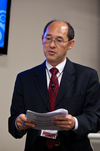Richard Lamb: Difference between revisions
No edit summary |
m clarify mep2 |
||
| (27 intermediate revisions by 4 users not shown) | |||
| Line 1: | Line 1: | ||
{{People | {{People | ||
|portrait | |portrait=RickLambPortrait.png | ||
|caricature = CaricatureComing.jpg | |caricature=CaricatureComing.jpg | ||
|country=USA | |||
|country | |email=slamb [at] xtcn.com | ||
|email | |linkedin = https://www.linkedin.com/in/naticklamb | ||
| | |userbox={{Template:UBX-ICANNSTAFF-P}} | ||
|userbox | |||
}} | }} | ||
'''Dr. Richard Lamb''' has over 40 years of engineering, business, security, and policy experience <ref>AAAS S&T Policy Fellow and IEEE-USA Executive Fellow</ref> in the Internet arena. His interests have been intertwined with the progress of technology from a very early age starting with radio circuitry to integrated circuitry to computers to networking and the Internet. Responsible for [[DNSSEC]] efforts at [[ICANN]], he was the technical and policy architect for the Internet’s original DNSSEC root key deployment <ref>IEEE Professional Achievement Award "For leadership in developing Internet security policy related to global PKI and DNSSEC"</ref><ref>[http://www.theregister.co.uk/2015/08/13/root_key_signing_ceremony/ Key Ceremony - The Register][http://www.theguardian.com/technology/2014/feb/28/seven-people-keys-worldwide-internet-security-web The Guardian]</ref><ref>[http://boingboing.net/2016/02/19/what-a-serious-keysigning-cer.html Serious Key Ceremony - Doctorow]</ref> and regularly teaches and speaks<ref>[https://www.youtube.com/watch?v=2bPRGabwL9k HKISOC]</ref><ref>[http://iccs.fordham.edu/program/iccs2012/richard-lamb/ ICCS]</ref><ref>[http://friendsoftheigf.org/session/335 IGF]</ref><ref>[https://www.icann.org/news/blog/a-week-in-europe-with-rick-lamb-helping-the-internet-community-contribute-to-a-stable-and-secure-internet SCS]</ref> on DNSSEC and other [[ICT]] topics. Prior to this, he was Director of Global IT policy at US Department of State where he focused on helping policymakers understand various technologies. Before this, he founded a number of small networking start-ups the last acquired by [[Microsoft]] and continues to collaborate with start-ups on innovative solutions and has a number of patents. His years in the networking field have included implementation of a wide range of protocols from the bottom-up including UUCP (author of UUPC/DCP), MCI Mail MEP2, BiSync, SNA/SDLC, X.25, DECNET, Q.921/931, H.323, IPX, NATs, and TCP/IP/DNS. Rick received his doctorate from MIT. <ref>[https://www.linkedin.com/pub/rick-lamb/0/213/ab linkedin]</ref> | |||
'''Richard Lamb''' has over | |||
==References== | ==References== | ||
{{reflist}} | {{reflist}} | ||
[[Category: | [[Category:Former ICANN Staff]] | ||
[[Category: | [[Category:DNSSEC]] | ||
[[Category:Policy Advisors]] | |||
Revision as of 19:25, 19 June 2023
 |
 | ||
| Country: | USA | ||
| Email: | slamb [at] xtcn.com | ||
| LinkedIn: | |||
| |||
Dr. Richard Lamb has over 40 years of engineering, business, security, and policy experience [1] in the Internet arena. His interests have been intertwined with the progress of technology from a very early age starting with radio circuitry to integrated circuitry to computers to networking and the Internet. Responsible for DNSSEC efforts at ICANN, he was the technical and policy architect for the Internet’s original DNSSEC root key deployment [2][3][4] and regularly teaches and speaks[5][6][7][8] on DNSSEC and other ICT topics. Prior to this, he was Director of Global IT policy at US Department of State where he focused on helping policymakers understand various technologies. Before this, he founded a number of small networking start-ups the last acquired by Microsoft and continues to collaborate with start-ups on innovative solutions and has a number of patents. His years in the networking field have included implementation of a wide range of protocols from the bottom-up including UUCP (author of UUPC/DCP), MCI Mail MEP2, BiSync, SNA/SDLC, X.25, DECNET, Q.921/931, H.323, IPX, NATs, and TCP/IP/DNS. Rick received his doctorate from MIT. [9]
